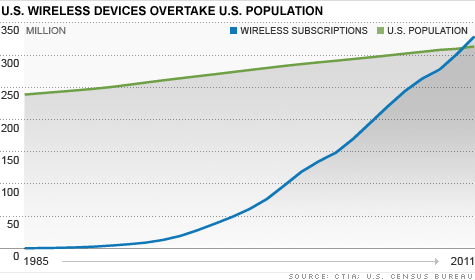Search News

NEW YORK (CNNMoney) -- The number of wireless devices in the United States now outnumbers the people living here.
Connected devices with wireless subscriptions rose to 327.6 million in the second quarter, according to a new report from wireless industry association CTIA. That represents a 9% increase since the same period last year. The U.S. population currently clocks in at 312.4 million, the U.S. Census Bureau said.
The growing popularity of smartphones and tablets like the iPad means that many Americans now have two or more devices with a wireless plan. The number of active U.S. smartphones increased 57% to 95.8 million, and tablets grew 17% to 15.2 million.
"Americans love wireless and continue to rely on the most cutting-edge and innovative devices," said Steve Largent, president of CTIA, in a statement. "Clearly, we're using wireless more every day, and the consensus of experts is that demand will continue to skyrocket by more than 50 times within the next five years."
In a sign that wireless habits are changing, voice minute usage increased just 1% to 1.2 trillion minutes, while texting increased 16% to 1.2 trillion messages.
Yet wireless data traffic grew 111% from a year ago to an astounding 341.2 petabytes (that's 341.2 billion megabytes) over the past year.
To keep up with demand, wireless carriers' investments in their networks topped $27.5 billion over the past 12 months, up 28% from a year earlier. Many carriers are in the process of building out their 4G networks, which offer faster speeds and more efficient use of wireless frequencies.
The good news for consumers is that, at the same time, the average monthly wireless bill actually fell slightly to $47.23, down from $47.47 a year ago. But CTIA noted that the rapid rise of data demand points to the nation's need for more wireless spectrum to relay that data.
The government has pledged that it would free up 500 MHz of spectrum for mobile broadband use, which would nearly double the amount of available spectrum for wireless companies. Though some experts say even that may be insufficient to keep up with customers' demands, it would at least delay the problem.
4G offers up to 20 times the capacity of some 3G networks. But by 2015, when 4G networks are fully built out, mobile data traffic is likely to have caught up.
Meanwhile, wireless companies are doing just fine. Their combined annual service revenue was $164.6 billion over the past year, up 6% from the same period last year. ![]()